Mount Cayley volcanic field
Coordinates: 50°07′13″N 123°17′26″W / 50.12028°N 123.29056°W
| Mount Cayley volcanic field | |
| MCVF | |
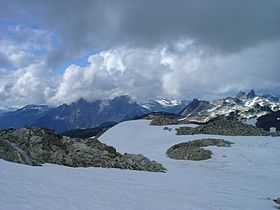 A view of the Mount Cayley volcanic field. The Mount Cayley massif is the large mountain to the left and Mount Fee is the relatively small jagged peak to the far right. | |
| Country | Canada |
|---|---|
| Province | British Columbia |
| District | New Westminster Land District |
| Part of | Garibaldi Volcanic Belt |
| Length | 31 km (19 mi) |
| Width | 6 km (4 mi) |
| Geology | Lava flows, stratovolcanoes, subglacial volcanoes |
| Period | Pliocene-to-Holocene |
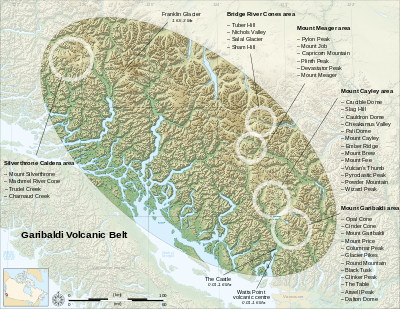 The extent of the Garibaldi Volcanic Belt showing the location of the Mount Cayley volcanic field (here referred as the "Mount Cayley area") and its volcanic features.
| |
The Mount Cayley volcanic field is a remote volcanic zone on the South Coast of British Columbia, Canada, stretching 31 km (19 mi) from the Pemberton Icefield to the Squamish River. It forms a segment of the Garibaldi Volcanic Belt, the Canadian portion of the Cascade Volcanic Arc, which extends from Northern California to southwestern British Columbia. Most of the Cayley volcanoes were formed during periods of volcanism under sheets of glacial ice throughout the last glacial period. These subglacial eruptions formed steep, flat-topped volcanoes and subglacial lava domes, most of which have been entirely exposed by deglaciation. However, at least two volcanoes predate the last glacial period and both are highly eroded. The field gets its name from Mount Cayley, the largest and most persistent volcano, located at the southern end of the Powder Mountain Icefield. This icefield covers much of the central portion of the volcanic field and is one of the several glacial fields in the Pacific Ranges of the Coast Mountains.
Eruptions along the length of the field began between 1.6 and 5.3 million years ago. At least 23 eruptions have occurred throughout its eruptive history. This volcanic activity ranged from effusive to explosive, with magma compositions ranging from basaltic to rhyolitic. Because the Mount Cayley volcanic field has a high elevation and consists of a cluster of mostly high altitude, non-overlapping volcanoes, subglacial activity is likely to have occurred under less than 800 m (2,600 ft) of glacial ice. The style of this glaciation promoted meltwater escape during eruptions. The steep profile of the volcanic field and its subglacial landforms support this hypothesis. As a result, volcanic features in the field that interacted with glacial ice lack rocks that display evidence of abundant water during eruption, such as hyaloclastite and pillow lava.
Of the entire volcanic field, the southern portion has the most known volcanoes. Here, at least 11 of them are situated on top of a long narrow mountain ridge and in adjacent river valleys. The central portion contains at least five volcanoes situated at the Powder Mountain Icefield. To the north, two volcanoes form a sparse area of volcanism. Many of these volcanoes were formed between 0.01 and 1.6 million years ago, some of which show evidence of volcanic activity in the past 10,000 years.
Geology
Formation
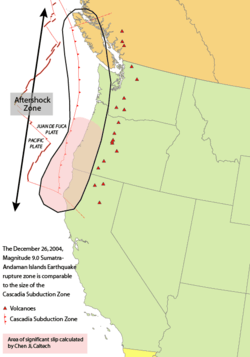
The Mount Cayley volcanic field formed as a result of the ongoing subduction of the Juan de Fuca Plate under the North American Plate at the Cascadia subduction zone along the British Columbia Coast.[1] This is a 1,094 km (680 mi) long fault zone running 80 km (50 mi) off the Pacific Northwest from Northern California to southwestern British Columbia. The plates move at a relative rate of over 10 mm (0.39 in) per year at an oblique angle to the subduction zone. Because of the very large fault area, the Cascadia subduction zone can produce large earthquakes of magnitude 7.0 or greater. The interface between the Juan de Fuca and North American plates remains locked for periods of roughly 500 years. During these periods, stress builds up on the interface between the plates and causes uplift of the North American margin. When the plate finally slips, the 500 years of stored energy are released in a massive earthquake.[2]
Unlike most subduction zones worldwide, there is no deep oceanic trench present along the continental margin in Cascadia.[3] The reason is that the mouth of the Columbia River empties directly into the subduction zone and deposits silt at the bottom of the Pacific Ocean, burying this large depression. Massive floods from prehistoric Glacial Lake Missoula during the Late Pleistocene also deposited large amounts of sediment into the trench.[4] However, in common with other subduction zones, the outer margin is slowly being compressed, similar to a giant spring.[2] When the stored energy is suddenly released by slippage across the fault at irregular intervals, the Cascadia subduction zone can create very large earthquakes, such as the magnitude 9.0 Cascadia earthquake on January 26, 1700.[5] However, earthquakes along the Cascadia subduction zone are less common than expected and there is evidence of a decline in volcanic activity over the past few million years. The probable explanation lies in the rate of convergence between the Juan de Fuca and North American plates. These two tectonic plates currently converge 3 cm (1.2 in) to 4 cm (1.6 in) per year. This is only about half the rate of convergence from seven million years ago.[3]
Scientists have estimated that there have been at least 13 significant earthquakes along the Cascadia subduction zone in the past 6,000 years. The most recent, the 1700 Cascadia earthquake, was recorded in the oral traditions of the First Nations people on Vancouver Island. It caused considerable tremors and a massive tsunami that traveled across the Pacific Ocean. The significant shaking associated with this earthquake demolished houses of the Cowichan Tribes on Vancouver Island and caused several landslides. Shaking due to this earthquake made it too difficult for the Cowichan people to stand, and the tremors were so lengthy that they were sickened. The tsunami created by the earthquake ultimately devastated a winter village at Pachena Bay, killing all the people that lived there. The 1700 Cascadia earthquake caused near-shore subsidence, submerging marshes and forests on the coast that were later buried under more recent debris.[5]
Subglacial volcanoes
Lying in the middle of the Mount Cayley volcanic field is a subglacial volcano named Slag Hill. At least two geological units compose the edifice. Slag Hill proper consists of andesite lava flows and small amounts of pyroclastic rock. Lying on the western portion of Slag Hill is a lava flow that likely erupted less than 10,000 years ago due to the lack of features indicating volcano-ice interactions.[6] The Slag Hill flow-dominated tuya 900 m (3,000 ft) northeast of Slag Hill proper consists of a flat-topped, steep-sided pile of andesite. It protrudes through remnants of volcanic material erupted from Slag Hill proper, but it represents a separate volcanic vent due to its geographical appearance. This small subglacial volcano possibly formed between 25,000 and 10,000 years ago throughout the waning stages of the Fraser Glaciation.[7]
Cauldron Dome, a subglacial volcano north of Mount Cayley, lies west of the Powder Mountain Icefield. Like Slag Hill, it is composed of two geological units. Upper Cauldron Dome is a flat-topped, oval-shaped pile of at least five andesite lava flows that resembles a tuya. The five andesite flows are columnar jointed and were likely extruded through glacial ice. The latest volcanic activity might have occurred between 10,000 and 25,000 years ago when this area was still influenced by glacial ice of the Fraser Glaciation. Lower Cauldron Dome, the youngest unit comprising the entire Cauldron Dome subglacial volcano, consists of a flat-topped, steep-sided pile of andesite lava flows 1,800 m (5,900 ft) long and a maximum thickness of 220 m (720 ft). These volcanics were extruded about 10,000 years ago during the waning stages of the Fraser Glaciation from a vent adjacent to upper Cauldron Dome that is currently buried under glacial ice.[8]
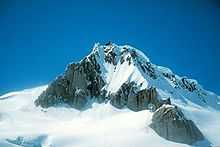
Ring Mountain, a flow-dominated tuya lying at the northern portion of the Mount Cayley volcanic field, consists of a pile of at least five andesite lava flows lying on a mountain ridge. Its steep-sided flanks reach heights of 500 m (1,600 ft) and are composed of volcanic rubble. This makes it impossible to measure its exact base elevation or how many lava flows constitute the edifice. With a summit elevation of 2,192 m (7,192 ft), Ring Mountain had its last volcanic activity between 25,000 and 10,000 years ago when the Fraser Glaciation was close to its maximum. Northwest of Ring Mountain lies a minor andesite lava flow. Its chemistry is somewhat unlike other andesite flows comprising Ring Mountain, but it probably erupted from a volcanic vent adjacent to or at Ring Mountain. The part of it that lies higher in elevation contains some features that indicate lava-ice interactions, while the lower-elevation portion of it does not. Therefore, this minor lava flow was likely extruded after Ring Mountain formed but when glacial ice covered a broader area than it does to this day, and that the lava flowed beyond the region in which glacial ice existed at that time.[9]
To the north lies Little Ring Mountain, another flow-dominated tuya lying at the northern portion of the Mount Cayley volcanic field. It consists of a pile of at least three andesite lava flows lying on a mountain ridge. Its steep-sided flanks reach heights of 240 m (790 ft) and are composed of volcanic rubble. This makes it impossible to measure its exact base elevation or how many lava flows comprise the edifice. With a summit elevation of 2,147 m (7,044 ft), Little Ring Mountain had its last volcanic activity between 25,000 and 10,000 years ago when the Fraser Glaciation was close to its maximum.[10]
Ember Ridge, a mountain ridge between Tricouni Peak and Mount Fee, consists of at least eight lava domes composed of andesite. They were likely formed between 25,000 and 10,000 years ago when lava erupted beneath glacial ice of the Fraser Glaciation. Their current structures are comparable to their original forms due to the minimal degree of erosion. As a result, the domes display the shapes and columnar joints typical of subglacial volcanoes. The random shapes of the Ember Ridge domes are the result of erupted lava taking advantage of former ice pockets, eruptions taking place on uneven surfaces, subsidence of the domes during volcanic activity to create rubble and separation of older columnar units during more recent eruptions. The northern dome, known as Ember Ridge North, covers the summit and eastern flank of the mountain ridge. It comprises at least one lava flow that reaches a thickness of 100 m (330 ft), as well as the thinnest columnar units in the Mount Cayley volcanic field. The small size of the columnar joints indicates that the erupted lava was cooled immediately and are mainly located on the dome's summit.[11] Ember Ridge Northeast, the smallest subglacial dome of Ember Ridge, comprises one lava flow that has a thickness no more than 40 m (130 ft).[12] Ember Ridge Northwest, the most roughly circular subglacial dome, comprises at least one lava flow.[13] Ember Ridge Southeast is the most complex of the Ember Ridge domes, consisting of a series of lava flows with a thickness of 60 m (200 ft). It is also the only Ember Ridge dome that contains large amounts of rubble.[14] Ember Ridge Southwest comprises at least one lava flow that reaches a thickness of 80 m (260 ft). It is the only subglacial dome of Ember Ridge that contains hyaloclastite.[15] Ember Ridge West comprises only one lava flow that reaches a thickness of 60 m (200 ft).[16]
Mount Brew, 18 km (11 mi) southwest of the resort town of Whistler, is a 1,757 m (5,764 ft) high lava dome composed of andesite or dacite that probably formed subglacially between 25,000 and 10,000 years ago.[17][18] It contains two masses of rock that might resemble ice-marginal lava flows. These edifices have not been studied in detail but they could have formed during the same period as the Ember Ridge subglacial domes due to their structures, columnar joints and compositions.[17]
Eroded edifices
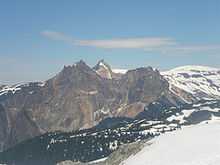
The Mount Cayley massif, 2,385 m (7,825 ft) in elevation, is the largest and most persistent volcano in the Mount Cayley volcanic field. It is a highly eroded stratovolcano composed of dacite and rhyodacite lava that was deposited during three phases of volcanic activity.[19][20] The first eruptive phase started about four million years ago with the eruption of dacite lava flows and pyroclastic rock.[20] This resulted in the creation of the Mount Cayley proper.[19] Subsequent volcanism during this volcanic phase constructed a significant lava dome. This acts like a volcanic plug and composes the lava spines that currently form pinnacles on Cayley's rugged summit.[20] After the Mount Cayley proper was constructed, lava flows, tephra and welded dacite rubble was erupted.[19] This second phase of activity 2.7 ± 0.7 million years ago resulted in the creation of the Vulcan's Thumb, a craggy volcanic ridge on the southern flank of the Mount Cayley proper.[19][20] Lengthy dissection from an extended period of erosion demolished much of the original stratovolcano. Volcanic activity after this prolonged period of erosion produced thick dacite lava flows from parasitic vents 300,000 years ago that extended into the Turbid and Shovelnose Creek valleys near the Squamish River.[19][20] This subsequently created two minor parasitic lava domes 200,000 years ago.[20] These three volcanic events in contrast to several others around Cayley in that they do not show signs of interaction with glacial ice.[19]
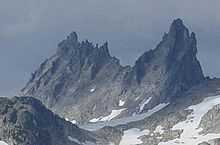
Immediately southeast of Mount Cayley lies Mount Fee, an extensively eroded volcano containing a north-south trending ridge. It has an elevation of 2,162 m (7,093 ft) and is one of the older volcanic features in the Mount Cayley volcanic field. Its volcanics are undated, but its large amount of dissection and evidence of glacial ice overriding the volcano indicates that it formed more than 75,000 years ago before the Wisconsinan Glaciation. Therefore, volcanism at Mount Fee does not display evidence of interaction with glacial ice. The remaining products from Fee's earliest volcanic activity is a minor portion of pyroclastic rock. This is evidence of explosive volcanism from Fee's eruptive history, as well as its first volcanic event. The second volcanic event produced a sequence of lavas and breccias on the eastern flank of the main ridge. These volcanics were likely deposited when a sequence of lava flows and broken lava fragments erupted from a volcanic vent and moved down the flanks during the construction of a large volcano. Following extensive dissection, renewed volcanism produced a viscous series of lava flows forming its narrow, flat-topped, steep-sided northern limit and the northern end of the main ridge. The conduit for which these lava flows originated from was likely vertical in structure and intruded through older volcanics deposited during Fee's earlier volcanic events. This volcanic event was also followed by a period of erosion, and likely one or more glacial periods. Extensive erosion following the last volcanic event at Mount Fee has created the rugged north-south trending ridge that currently forms a prominent landmark.[21]
Pali Dome, located north and northeast of Mount Cayley, is an eroded volcano in the central Mount Cayley volcanic field. Like Cauldron Dome, it consists of two geological units. Pail Dome East is composed of a mass of andesite lava flows and small amounts of pyroclastic material. It lies on the eastern portion of the Powder Mountain Icefield. Much of the lava flows form gentle topography at high elevations but terminate in finely jointed vertical cliffs at low elevations. The first volcanic activity likely occurred about 25,000 years ago, but it could also be significantly older.[22] The most recent volcanic activity produced a series of lava flows that were erupted when the vent area was not covered by glacial ice. However, the flows show evidence of interaction with glacial ice in their lower units. This indicates that the lavas were erupted about 10,000 years ago during the waning stages of the Fraser Glaciation. The ice-marginal lava flows reach thicknesses of up to 100 m (330 ft).[22] Pali Dome West consists of at least three andesite lava flows and small amounts of pyroclastic material; its vent is presently buried under glacial ice.[23] At least three eruptions have occurred at Pali Dome East. The age of the first volcanic eruption is unknown, but it could have occurred in the past 10,000 years. The second eruption produced a lava flow that was erupted when the vent area was not buried under glacial ice. However, the flow does show evidence of interaction with glacial ice at its lower unit. This indicates that the lavas were erupted during the waning stages of the Fraser Glaciation. The third and most recent eruption produced another lava flow that was largely erupted above glacial ice, but was probably constrained on its northern margin by a small glacier. Unlike the lava flow that was erupted during the second eruption, this lava flow was not impounded by glacial ice at its lower unit. This suggests that it erupted less than 10,000 years ago when the regional Fraser Glaciation retreated.[23]
Lava flows
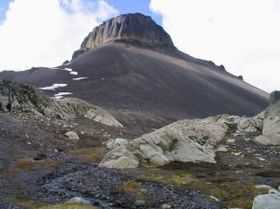
At least two sequences of basaltic andesite lava flows are deposited south of Tricouni Peak. One of these sequences, known as Tricouni Southwest, creates a cliff on the eastern side of a north-south trending channel with a depth of 200 m (660 ft) adjacent to the High Falls Creek mouth. The eastern flank of the lava flow, outside the High Falls Creek channel, has a more constant structure. Several fine-scale columnar joints and the overall structure of the lava flow suggest that its western portion, along the length of the channel, ponded against glacial ice. Near its southern unit, lava oozed into cracks in the glacial ice. This has been identified by the existence of spire-like cooling formations, although many of these edifices have been destroyed by erosional processes. Other features that indicate the lava ponded against glacial ice include its unusually thick structure and its steep cliffs. Therefore, the Tricouni Southwest lava flow was erupted about 10,000 years ago when the regional Fraser Glaciation was retreating. The explanation for the western portion displaying ice-contact features while the eastern portion does not is likely because its western flank lies in a north-south trending channel, which would have been able to maintain smaller amounts of solar heat than its unsheltered eastern flank. As a result, the western portion of the lava flow records glaciation during a period when the eastern slopes were free from glacial ice.[24]
Tricouni Southeast, another volcanic sequence south of Tricouni Peak, consists of at least four andesite or dacite lava flows that outcrop as several small cliffs and bluffs on extensively vegetated flanks. They reach thicknesses of 100 m (330 ft) and contain small amounts of hyaloclastite. The feeder of their origins has not been discovered but is likely located at the summit of the mound. These lavas form ice-marginal edifies, suggesting that every lava flow was erupted about 10,000 years ago when the vast Cordilleran Ice Sheet was retreating and remains of glacial ice was sparse.[25]
Exposed along the Cheakamus River and its tributaries are the Cheakamus Valley basalts. Although not necessarily mapped as part of the Cayley field, this sequence of basaltic lava flows is geologically similar and comparable in age to volcanic features that are part of this volcanic field. At least four basaltic flows comprise the sequence and were deposited during periods of volcanic activity from an unknown vent between 0.01 and 1.6 million years ago. Pillow lava is abundant along the bases the flows, some of which are underlain by hyaloclastite breccia. In 1958, Canadian volcanologist Bill Mathews suggested that the lava flows were erupted during periods of subglacial activity and traveled through trenches or tunnels melted in glacial ice of the Fraser Glaciation. Mathews based this on the age of the underlying till, the existence of pillow lava close to the bottom of some lavas, indicating subaqueous volcanism, the columnar jointing at the edges of the lavas, indicating rapid cooling, and the absence of apparent palaeogeography.[26]
Petrography
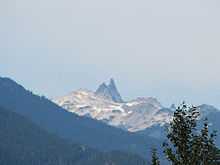
The andesite lava of Ember Ridge comprises 55% brownish-green volcanic glass with a trachytic matrix of plagioclase. About 35% of Ember Ridge andesite contains phenocrysts of hornblende, augite, plagioclase and orthopyroxene and exist as isolated crystals and clots. A feature south of Ember Ridge, unofficially known as Betty's Bump, comprises andesite with phenocrysts of plagioclase, augite and olivine. Dark brown volcanic glass composes the Betty's Bump andesite as much as 20%. The relationship of Betty's Bump with Ember Ridge is unclear but it likely represents a separate volcanic feature due to its topographic isolation.[1]
Little Ring Mountain at the northern end of the field contains at least 70% brown volcanic glass with isolated phenocrysts of plagioclase. Vesicular textures are up to 5%, suggesting that the lava erupted subaerially. Probable xenocrysts of quartz have been identified at the volcano. At least one xenolith fragment has been found in loose rubble at the volcano and included several quartz xenocrysts and polycrystalline quartz xenoliths in a glassy matrix with trachytic plagioclase.[1]
The dacite volcanics composing Mount Fee contain brown volcanic glass as much as 70% and vesicular textures as much as 15%. About 25% of the volcanics contain crystal content, including plagioclase, hornblende, orthopyroxene, orthoclase and sporadic quartz. The orthoclase crystals are interpreted to represent rock fragments that became enveloped during hardening of the dacitic lavas. A portion of the southwestern flank of Mount Fee comprises no volcanic glass, but rather composed of an abnormal cryptocrystalline matrix. This indicates that it might have developed as part of a subvolcanic intrusion.[1]
At Ring Mountain, andesite comprises 70% brown volcanic glass and vesicular textures as much as 15%. The plagioclastic matrix is trachytic. Augite, biotite, plagioclase and hornblende occur as microphenocrysts and comprise 1% to 7% of the andesite. Small qualities of quartz are common and occur as microxenocrysts. Microxenocrysts of orthoclase likely exist in andesite at Ring Mountain.[1]
Andesite at Slag Hill consists of 70% dark brown volcanic glass with varied degrees of trachytic texture in the plagioclastic matrix and less than 5% of the andesite comprises vesicular textures. Plagioclase, hornblende and augite are mostly in form as phenocrysts and comprise 1% to 10% of the andesite. Orthoclase crystals are found occasionally and they likely represent xenocrysts.[1]
Geothermal and seismic activity

At least four seismic events have occurred at Mount Cayley since 1985 and is the only volcano that has recorded seismic activity in the field.[27] This suggests that the volcano still contains an active magma system, indicating the possibility of future eruptive activity.[28] Although the available data does not allow a clear conclusion, this observation indicates that some volcanoes in the Mount Cayley field may be active, with significant potential hazards. This seismic activity correlates both with some of Canada's most youthful volcanoes and with long-lived volcanoes with a history of significant explosive activity, such as Mount Cayley.[27] Recent seismic imaging from Natural Resources Canada employees supported lithoprobe studies in the region of Mount Cayley that created a large reflector interpreted to be a pool of molten rock roughly 15 km (9.3 mi) below the surface.[29] It is estimated to be 3 km (1.9 mi) long and 1 km (0.62 mi) wide with a thickness of less than 1.6 km (0.99 mi). The reflector is understood to be a sill complex associated with the formation of Mount Cayley. However, the available data does not rule out the probability of it being a body of molten rock created by dehydrating of the subducted Juan de Fuca Plate. It is located just beneath the weak lithosphere like those found under subduction zone volcanoes in Japan.[30]
At least five hot springs exist in valleys near Mount Cayley, providing more evidence for magmatic activity.[19] This includes springs found at Shovelnose Creek and Turbid Creek on the southern flank of Mount Cayley and Brandywine Creek on the eastern flank of the volcanic field.[31] They are generally found in areas of volcanic activity that are geologically young. As the regional surface water percolates downward through rocks below the Mount Cayley field, it reaches areas of high temperatures surrounding an active or recently solidified magma reservoir. Here, the water is heated, becomes less dense and rises back to the surface along fissures or cracks. These features are sometimes referred to as dying volcanoes because they seem to represent the last stage of volcanic activity as the magma at depth cools and hardens.[32]
Human history
Occupation
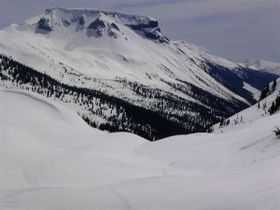
Several volcanic features in the Mount Cayley field were illustrated by volcanologist Jack Souther in 1980, including Mount Cayley, Cauldron Dome, Slag Hill, Mount Fee, Ember Ridge and Ring Mountain, which was titled Crucible Dome at the time. This resulted in the creation of a geologic map that showed the regional terrain and locations of the volcanoes.[1] The most detailed study of Mount Cayley took place during this period.[19] Little Ring Mountain at the northernmost end of the field had not been studied at the time and was not included on Souther's 1980 map.[1] Ember Ridge at the southern end of the field was originally mapped as a cluster of five lava domes. The sixth lava dome, Ember Ridge Northeast, was discovered by Ph.D. student Melanie Kelman during a period of research in 2001.[12][28]
The hot springs adjacent to Mount Cayley have made the volcanic field a target for geothermal exploration. At least 16 geothermal sites have been identified in British Columbia, Mount Cayley being one of the six areas most capable for commercial development. Others include Meager Creek and Pebble Creek near Pemberton, Lakelse Hot Springs near Terrace, Mount Edziza on the Tahltan Highland and the Lillooet Fault Zone between Harrison Lake and the community of Lillooet.[33] Temperatures of 50 °C (122 °F) to more than 100 °C (212 °F) have been measured in shallow boreholes on the southwestern flank of Mount Cayley.[20] However, its severe terrain makes it challenging to develop a proposed 100 megawatt power station in the area.[33]
Early impressions
The line of volcanoes has been the subject of myths and legends by First Nations. To the Squamish Nation, Mount Cayley is called tak'takmu'yin tl'a in7in'axa7en. In their language it means "Landing Place of the Thunderbird".[34] The Thunderbird is a legendary creature in North American indigenous peoples' history and culture. When the bird flaps its wings, thunder is created, and lightning originates from its eyes.[35] The rocks that make up Mount Cayley were said to have been burnt black by the Thunderbird's lightning. This mountain, like others in the area, is considered sacred because it plays an important part of their history. The Black Tusk, a pinnacle of black volcanic rock on the north shore of Garibaldi Lake to the southeast, sustains the same name.[34] Cultural ceremonial use, hunting, trapping and plant gathering occur around the Mount Garibaldi area, but the most important resources was a lithic material called obsidian. Obsidian is a black volcanic glass used to make knives, chisels, adzes and other sharp tools in pre-contact times. Glassy rhyodacite was also collected from a number of minor outcrops on the flanks of Mount Fee, Mount Callaghan and Mount Cayley. This material appears in goat hunting sites and at the Elaho rockshelter, collectively dated from about 8,000 to 100 years old.[35]
A number of volcanic peaks in the Mount Cayley field were named by mountaineers that explored the area in the early 20th century. Mount Fee was named in September 1928 by British mountaineer Tom Fyles after Charles Fee (1865–1927), who was a member of the British Columbia Mountaineering Club in Vancouver at the time.[36] To the northwest, Mount Cayley was named in September 1928 by Tom Fyles after Beverley Cochrane Cayley during a climbing expedition with the Alpine Club of Canada. Cayley was a friend of those in the climbing expedition and had died in Vancouver on June 8, 1928 at the age of 29. Photographs of Mount Cayley were taken by Fyles during the 1928 expedition and were published in the 1931 Canadian Alpine Journal Vol XX.[37]
Protection and monitoring
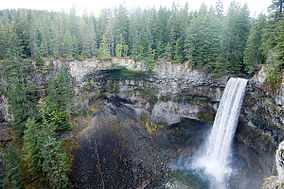
At least one feature in the Mount Cayley volcanic field is protected as a provincial park. Brandywine Falls Provincial Park at the southeastern end of the field was established to protect Brandywine Falls, a 70 m (230 ft) high waterfall on Brandywine Creek. It is composed of at least four lava flows of the Cheakamus Valley basalts. They are exposed in cliffs compassing the falls with a narrow sequence of gravel lying above the oldest lava unit. These lava flows are interpreted to have been exposed by erosion during a period of catastrophic flooding and the valley these lavas are located in is significantly larger than the river within it. The massive flooding that shaped the valley has been a subject of geological studies by Catherine Hickson and Andree Blais-Stevens. It has been proposed that there could have been significant floods during the waning stages of the last glacial period as drainage in a valley further north was blocked with remnants of glacial ice. Another possible explanation is subglacial eruptions created large amounts of glacial meltwater that scoured the surface of the exposed lava flows.[26]
Like other volcanic zones in the Garibaldi Belt, volcanoes in the Mount Cayley field are not monitored closely enough by the Geological Survey of Canada to ascertain how active their magma systems are. This is partly because the field is located in a remote region and no major eruptions have occurred in Canada in the past few hundred years. As a result, volcano monitoring is less important than dealing with other natural processes, including tsunamis, earthquakes and landslides.[38] However, with the existence of earthquakes, further volcanism is expected and would probably have considerable effects, particularly in a region like southwestern British Columbia where the Garibaldi Belt is located in a highly populated area.[38][39] Because of these concerns, significant support from Canadian university scientists have resulted in the construction of a baseline of knowledge on the state of the Garibaldi volcanoes. This improvement is continuous and will support the understanding to monitor volcanoes in the Mount Cayley field for future volcanism.[38]
Volcanic hazards
The Mount Cayley field is one of the largest volcanic zones in the Garibaldi Belt. Smaller zones include the Garibaldi Lake volcanic field surrounding Garibaldi Lake and the Bridge River Cones on the northern flank of the upper Bridge River. These areas are adjacent to Canada's populated southwest corner where the population of British Columbia is the greatest.[29]
A large volcanic eruption from any volcanoes in the Mount Cayley field would have major effects on the Sea-to-Sky Highway and municipalities such as Squamish, Whistler, Pemberton and probably Vancouver. Because of these concerns, the Geological Survey of Canada is planning to create hazard maps and emergency plans for Mount Cayley, as well as Mount Meager north of the volcanic field, which experienced a major volcanic eruption 2,350 years ago similar to the 1980 eruption of Mount St. Helens.[28][39]
Landslides

Like many other volcanoes in the Garibaldi Volcanic Belt, Mount Cayley has been the source for several large landslides. To date, most geological studies of the Mount Cayley field have focused on landslide hazards along with geothermal potential. A major debris avalanche about 4,800 years ago dumped 8 km2 (3.1 sq mi) of volcanic material into the adjacent Squamish valley.[1] This blocked the Squamish River for a long period of time.[40] Evans (1990) has indicated that a number of landslides and debris flows at Mount Cayley in the past 10,000 years might have been caused by volcanic activity.[29] Since the large debris avalanche 4,800 years ago, a number of more minor landslides have occurred at it, including one 1,100 years ago and another event 500 years ago.[40] Both landslides ultimately blocked the Squamish River and created lakes upstream that lasted for a limited amount of time.[41] In 1968 and 1983, a series of landslides took place that caused considerable damage to logging roads and forest stands, but did not result in any casualties.[42] Future landslides from Mount Cayley and potential damming of the Squamish River are significant geological hazards to the general public, as well as to the economic development in the Squamish valley.[41]
Eruptions
Eruptive activity in the Mount Cayley volcanic field is typical of past volcanism elsewhere in the Garibaldi Belt. Large earthquakes would occur under the volcanic field weeks to years in advance as molten rock intrudes through the Earth's rocky lithosphere. The extent of earthquakes and the local seismographs in this region would warn the Geological Survey of Canada and possibly cause an upgrade in monitoring. While molten rock breaks through the crust, the size of the volcano vulnerable to an eruption would probably swell and the area would rupture, creating much more hydrothermal activity at the regional hot springs and the formation of new springs or fumaroles. Small and probably significant rock avalanches may result and could dam the nearby Squamish River for a limited amount of time, such as those that occurred in the past without seismic activity and deformation related to magmatic activity. At some point the subsurface magma will produce phreatic eruptions and lahars. At this time Highway 99 would be out of service and the residents of Squamish would have to travel away from the eruptive zone.[27]

While molten rock comes closer to the surface it would most likely cause more fragmentation, triggering an explosive eruption that could produce an eruption column with an elevation of 20 km (12 mi) and may be sustained for 12 hours.[27] A well-documented explosive eruption in the Garibaldi Belt with such force is the eruption of Mount Meager 2,350 years ago, which deposed ash as far east as Alberta.[43] This would endanger air traffic and would have to take another route away from the eruptive zone. Every airport buried under pyroclastic fall would be out of service, including those in Vancouver, Victoria, Kamloops, Prince George and Seattle. The tephra would destroy power transmission lines, satellite dishes, computers and other equipment that operates on electricity. Therefore, telephones, radios and cell phones would be disconnected. Structures not built for holding heavy material would likely demolish under the weight of the tephra. Ash from the eruption plume would subside above the vent area to create pyroclastic flows and would travel east and west down the nearby Cheakamus and Squamish river valleys. These would likely have significant impacts on salmon in the associated rivers and would cause considerable melting of glacial ice to produce debris flows that may extend into Daisy Lake and Squamish to cause significant damage. The eruption column would then travel eastward and extract air travel throughout Canada from Alberta to Newfoundland and Labrador.[27]
Explosive eruptions may decrease and be followed by the eruption of viscous lava to form a lava dome in the newly formed crater. Precipitation would frequently trigger lahars and these would continuously create problems in the Squamish and Cheakamus river valleys. If the lava dome continues to grow, it would eventually rise above the crater rim. The lava would be cooling and expanding then may produce landslides to create a massive zone of blocky talus in the Squamish river valley. While the dome of lava grows, it would frequently subside to create large pyroclastic flows that would again travel down the adjacent Squamish and Cheakamus river valleys. Tephra swept away from the pyroclastic flows would create ash columns with elevations of at least 10 km (6.2 mi), repeatedly depositing tephra on the communities of Whistler and Pemberton and again disrupting regional air traffic. Lava of the unstable dome may occasionally create minor pyroclastic flows, explosions and eruption columns. The community of Squamish would be abandoned, Highway 99 would be out of service and destroyed, and traffic adjacent to Vancouver, Pemberton and Whistler would remain forced to travel along a route to the east that is more lengthy than Highway 99.[27]
Eruptions would likely continue for a period of time, followed by years of decreasing secondary activity. The solidifying lava would occasionally collapse portions of the volcano to create pyroclastic flows. Rubble on the flanks of the volcano and in valleys would occasionally be released to form debris flows. Major construction would be needed to repair the community of Squamish and Highway 99.[27]
See also
- List of Cascade volcanoes
- List of volcanoes in Canada
- Geology of British Columbia
- Callaghan Valley
- Lillooet Ranges
- Squamish volcanic field
- Volcanism of Western Canada
References
![]() This article incorporates public domain material from websites or documents of the United States Geological Survey.
This article incorporates public domain material from websites or documents of the United States Geological Survey.
- ↑ 1.0 1.1 1.2 1.3 1.4 1.5 1.6 1.7 1.8 Kelman, M.C.; Russell, J.K.; Hickson, C.J. (2001). Preliminary petrography and chemistry of the Mount Cayley volcanic field, British Columbia. Geological Survey of Canada. 2001-A11 (Natural Resources Canada). pp. 2, 3, 4, 7, 8, 14. ISBN 0-662-29791-1. Retrieved 2014-07-27.
- ↑ 2.0 2.1 "Cascadia Subduction Zone". Geodynamics. Natural Resources Canada. 2008-01-15. Retrieved 2010-03-06.
- ↑ 3.0 3.1 "Pacific Mountain System – Cascades volcanoes". United States Geological Survey. 2000-10-10. Retrieved 2010-03-05.
- ↑ Dutch, Steven (2003-04-07). "Cascade Ranges Volcanoes Compared". University of Wisconsin. Retrieved 2010-05-21.
- ↑ 5.0 5.1 "The M9 Cascadia Megathrust Earthquake of January 26, 1700". Natural Resources Canada. 2010-03-03. Retrieved 2010-03-06.
- ↑ "Slag Hill". Catalogue of Canadian volcanoes. Natural Resources Canada. 2009-03-10. Retrieved 2010-03-04.
- ↑ "Slag Hill tuya". Catalogue of Canadian volcanoes. Natural Resources Canada. 2009-03-10. Retrieved 2010-03-08.
- ↑ "Cauldron Dome". Catalogue of Canadian volcanoes. Natural Resources Canada. 2009-03-10. Retrieved 2010-03-07.
- ↑ "Ring Mountain (Crucible Dome)". Catalogue of Canadian volcanoes. Natural Resources Canada. 2009-03-10. Retrieved 2010-03-07.
- ↑ "Little Ring Mountain". Catalogue of Canadian volcanoes. Natural Resources Canada. 2009-03-10. Retrieved 2010-03-08.
- ↑ "Ember Ridge North". Catalogue of Canadian volcanoes. Natural Resources Canada. 2009-03-10. Retrieved 2010-03-28.
- ↑ 12.0 12.1 "Ember Ridge Northeast". Catalogue of Canadian volcanoes. Natural Resources Canada. 2009-03-10. Retrieved 2010-03-28.
- ↑ "Ember Ridge Northwest". Catalogue of Canadian volcanoes. Natural Resources Canada. 2009-03-10. Retrieved 2010-03-28.
- ↑ "Ember Ridge Southeast". Catalogue of Canadian volcanoes. Natural Resources Canada. 2009-03-10. Retrieved 2010-03-28.
- ↑ "Ember Ridge Southwest". Catalogue of Canadian volcanoes. Natural Resources Canada. 2009-03-10. Retrieved 2010-03-28.
- ↑ "Ember Ridge West". Catalogue of Canadian volcanoes. Natural Resources Canada. 2009-03-10. Retrieved 2010-03-28.
- ↑ 17.0 17.1 "Mount Brew". Catalogue of Canadian volcanoes. Natural Resources Canada. 2009-03-10. Retrieved 2010-04-16.
- ↑ Smellie, J.L.; Chapman, Mary G. (2002). Volcano-Ice Interaction on Earth and Mars. Geological Society of London. p. 201. ISBN 1-86239-121-1.
- ↑ 19.0 19.1 19.2 19.3 19.4 19.5 19.6 19.7 "Garibaldi Volcanic Belt: Mount Cayley volcanic field". Catalogue of Canadian volcanoes. Natural Resources Canada. 2009-04-07. Retrieved 2010-04-12.
- ↑ 20.0 20.1 20.2 20.3 20.4 20.5 20.6 Wood, Charles A.; Kienle, Jürgen (2001). Volcanoes of North America: United States and Canada. Cambridge, England: Cambridge University Press. p. 142. ISBN 978-0-521-43811-7. OCLC 27910629.
- ↑ "Mount Fee". Catalogue of Canadian volcanoes. Natural Resources Canada. 2009-03-10. Retrieved 2010-03-03.
- ↑ 22.0 22.1 "Pali Dome East". Catalogue of Canadian volcanoes. Natural Resources Canada. 2009-03-10. Retrieved 2010-03-07.
- ↑ 23.0 23.1 "Pali Dome West". Catalogue of Canadian volcanoes. Natural Resources Canada. 2009-03-10. Retrieved 2010-03-07.
- ↑ "Tricouni Southwest". Catalogue of Canadian volcanoes. Natural Resources Canada. 2009-03-10. Retrieved 2010-05-16.
- ↑ "Tricouni Southeast flows". Catalogue of Canadian volcanoes. Natural Resources Canada. 2009-03-10. Retrieved 2010-05-16.
- ↑ 26.0 26.1 Stelling, Peter L.; Tucker, David Samuel (2007). "Floods, Faults, and Fire: Geological Field Trips in Washington State and Southwest British Columbia". Current Research, Part A (Geological Society of America): 12, 13, 14. ISBN 978-0-8137-0009-0.
- ↑ 27.0 27.1 27.2 27.3 27.4 27.5 27.6 Etkin, David; Haque, C.E.; Brooks, Gregory R. (2003-04-30). An Assessment of Natural Hazards and Disasters in Canada. Springer Science+Business Media. pp. 579, 580, 582. ISBN 978-1-4020-1179-5. Retrieved 2014-07-27.
- ↑ 28.0 28.1 28.2 "Volcanology in the Geological Survey of Canada". Volcanoes of Canada. Natural Resources Canada. 2007-10-10. Retrieved 2010-04-13.
- ↑ 29.0 29.1 29.2 Monger, J.W.H. (1994). "Character of volcanism, volcanic hazards, and risk, northern end of the Cascade magmatic arc, British Columbia and Washington State". Geology and Geological Hazards of the Vanvouver Region, Southwestern British Columbia. Natural Resources Canada. pp. 232, 236, 241. ISBN 0-660-15784-5.
- ↑ Hammer, P.T.C.; Clowes, R.M. (1996). "Seismic reflection investigations of the Mount Cayley bright spot: A midcrustal reflector beneath the Coast Mountains, British Columbia". Journal of Geophysical Research: Solid Earth (American Geophysical Union) 101 (B9): 20119–20131. Bibcode:1996JGR...10120119H. doi:10.1029/96JB01646. ISSN 0148-0227.
- ↑ "Geothermal Energy Potential". Callaghan Lake Provincial Park: Background Report (PDF) (Report). Terra Firma Environmental Consultants. 1998-03-15. p. 6. Retrieved 2010-04-27.
- ↑ "Geysers, Fumaroles, and Hot Springs". United States Geological Survey. 1997-01-31. Retrieved 2010-04-27.
- ↑ 33.0 33.1 "BC Hydro Green & Alternative Energy Division" (PDF). BC Hydro. 2002. p. 20. Retrieved 2010-04-27.
- ↑ 34.0 34.1 Yumks; Reimer, Rudy (April 2003). "Squamish Traditional Use Study: Squamish Traditional Use of Nch'kay Or the Mount Garibaldi and Brohm Ridge Area" (PDF). Draft. First Heritage Archaeological Consulting. p. 17. Retrieved 2010-03-30.
- ↑ 35.0 35.1 Reimer/Yumks, Rudy. "Squamish Nation Cognitive Landscapes" (PDF). McMaster University. pp. 8, 9. Retrieved 2008-05-19.
- ↑ "Mount Fee". BC Geographical Names Information System. Government of British Columbia. Retrieved 2010-07-22.
- ↑ "Mount Cayley". BC Geographical Names Information System. Government of British Columbia. Retrieved 2010-07-22.
- ↑ 38.0 38.1 38.2 "Monitoring volcanoes". Volcanoes of Canada. Natural Resources Canada. 2009-02-26. Retrieved 2010-03-24.
- ↑ 39.0 39.1 "Garibaldi volcanic belt". Catalogue of Canadian volcanoes. Natural Resources Canada. 2009-04-02. Retrieved 2010-02-20.
- ↑ 40.0 40.1 G. Evans, S.; Brooks, G. R. (1992). "Prehistoric debris avalanches from Mount Cayley volcano, British Columbia:1 Reply". Natural Resources Canada. p. 1346. Retrieved 2010-03-03.
- ↑ 41.0 41.1 Monger, J.W.H. (1994). "Debris avalanches in Quaternary volcanic rocks, Garibaldi Volcanic Belt". Geology and geological hazards of the Vancouver region, southwestern British Columbia (PDF). Natural Resources Canada. pp. 270, 272. Retrieved 2010-04-26.
- ↑ "Photo Collection". Landslides. Natural Resources Canada. 2007-02-05. Retrieved 2010-03-03.
- ↑ "Garabaldi volcano belt: Mount Meager volcanic field". Catalogue of Canadian volcanoes. Natural Resources Canada. 2009-04-01. Retrieved 2010-05-12.
External links
| Wikimedia Commons has media related to Mount Cayley volcanic field. |
- "Garibaldi Volcanic Belt". Map of Canadian volcanoes. Natural Resources Canada. 2005-08-20. Retrieved 2010-07-30.
- "Garibaldi Volcanic Belt (Mount Cayley area)". Map of Canadian volcanoes. Natural Resources Canada. 2005-08-20. Retrieved 2010-07-30.
| ||||||||||